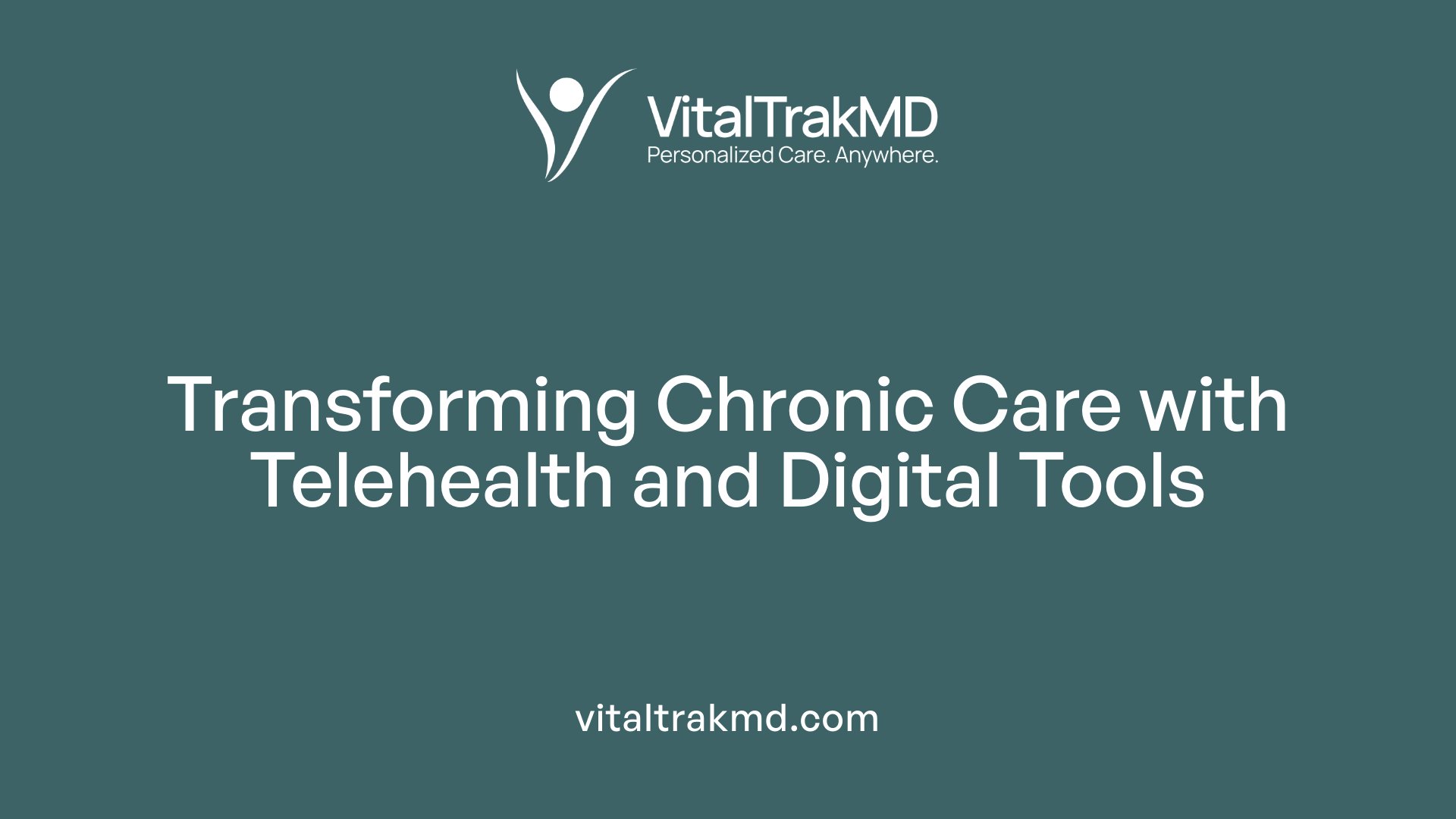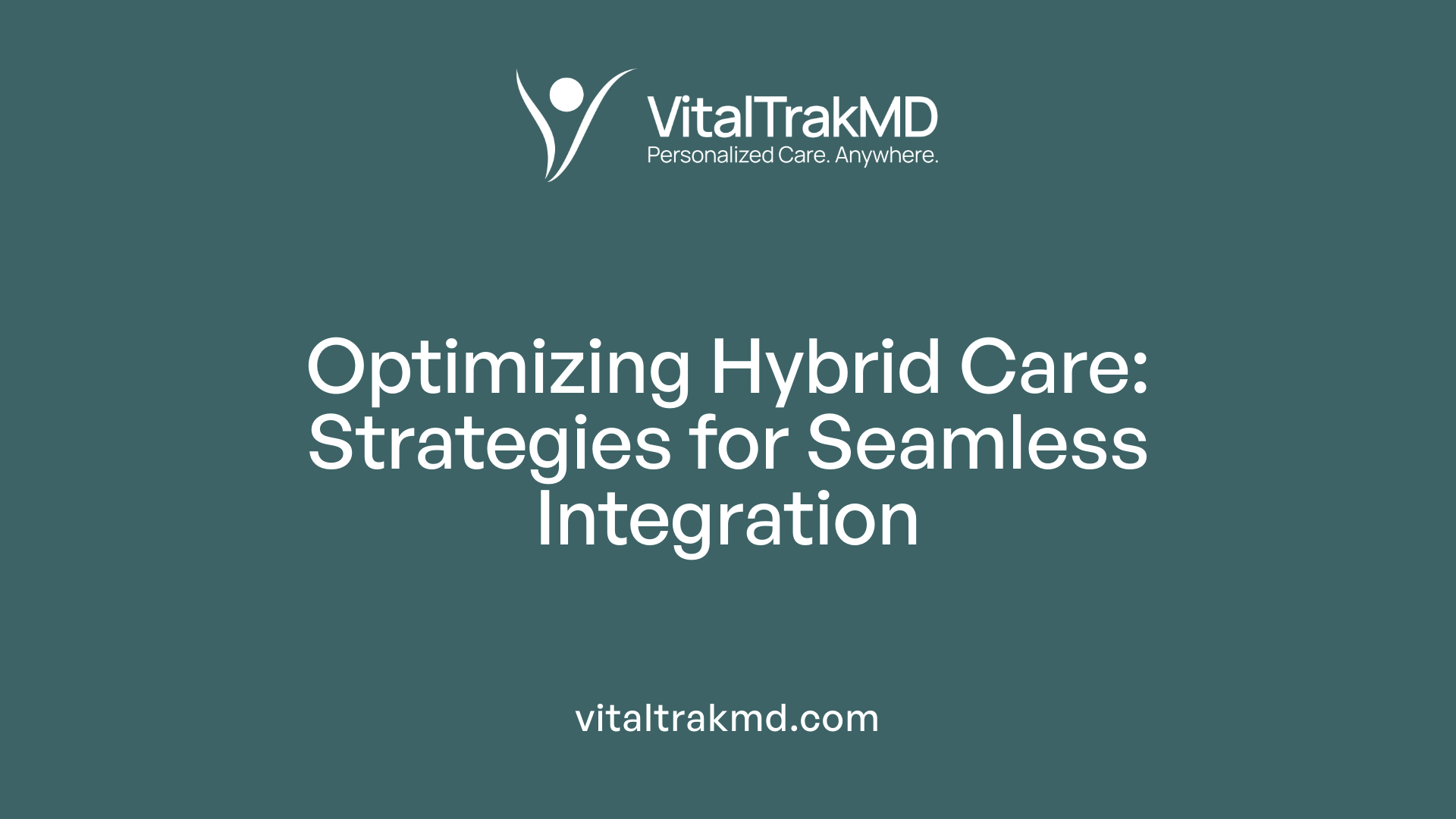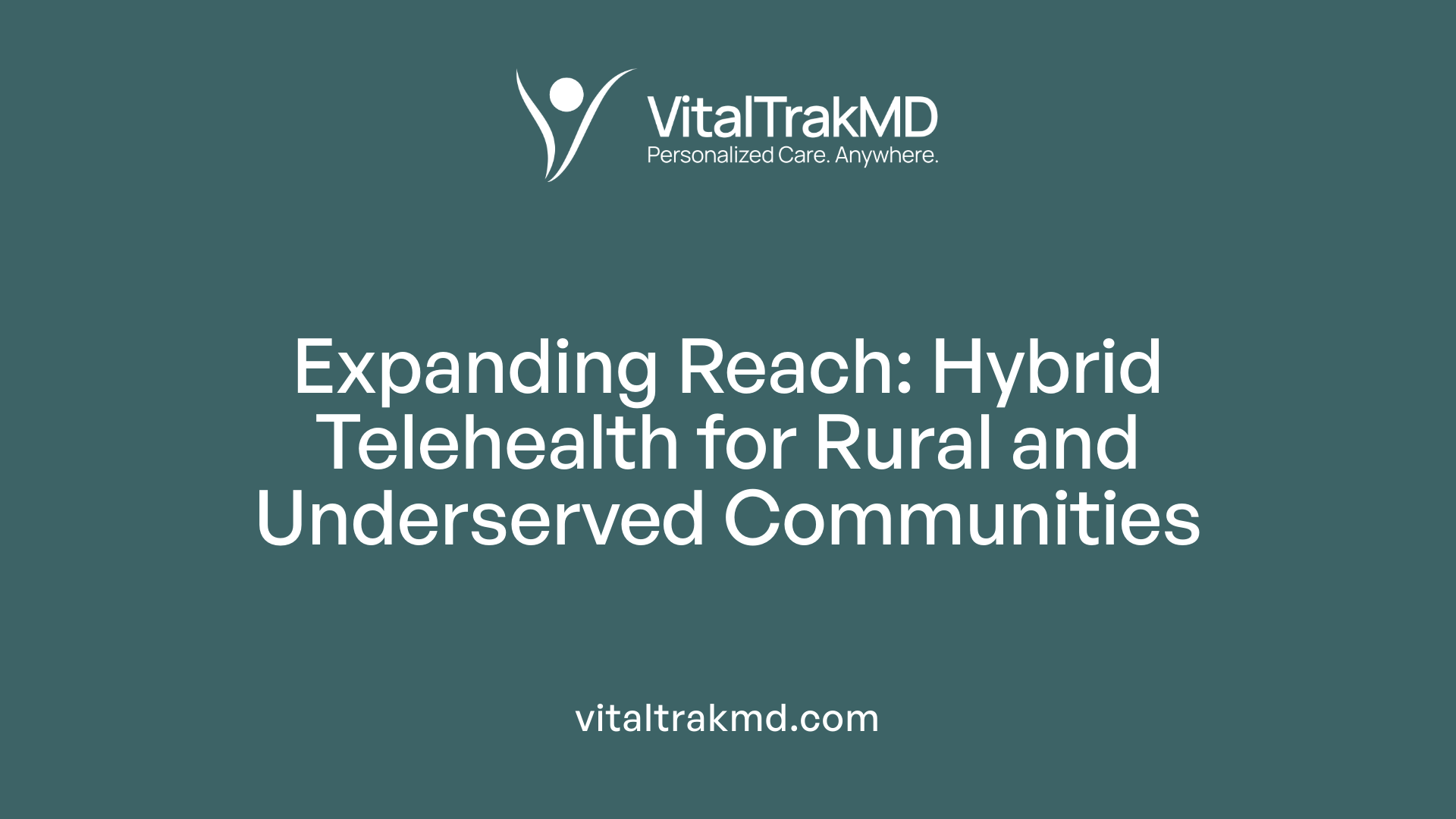The Role of Hybrid Care in Preventing Gaps in Chronic Disease Management

Understanding the Critical Role of Hybrid Care in Chronic Disease Management
As the healthcare landscape evolves, hybrid care has emerged as a vital approach to ensuring continuous, accessible, and patient-centered management of chronic diseases. By integrating traditional in-person visits with telehealth solutions, hybrid care models address pivotal challenges such as resource limitations, provider shortages, and disruptions like the COVID-19 pandemic. This article explores the multifaceted role of hybrid care, technological innovations supporting it, and strategies for effective implementation across various healthcare settings.
Defining Hybrid Care and Its Components
What does hybrid care primarily involve? Hybrid healthcare combines traditional face-to-face clinical visits with telehealth services and digital tools, creating a flexible and patient-focused approach. This integration allows patients to experience more accessible and personalized healthcare experiences by leveraging technology to augment in-person care.
The main elements of hybrid healthcare models include three core components: telehealth consultations, in-person visits, and health education. Telehealth involves real-time virtual visits through video or phone calls, especially for follow-up appointments with stable chronic disease patients, reducing the need for physical presence. In-person consultations are reserved for physical exams, complex diagnoses, and procedures requiring direct contact. Health education encompasses self-care classes, nutrition advice, and emotional support, delivered both synchronously (live) and asynchronously (recorded or online).
How do hybrid models support continuous and comprehensive care? They facilitate ongoing communication, remote monitoring, and timely interventions, which are especially important in managing chronic diseases. Remote therapeutic monitoring uses connected devices to track vital signs and health metrics from home, enabling early detection of potential health issues.
Moreover, hybrid healthcare adapts to various patient needs and circumstances, enhancing access for underserved populations or those with mobility challenges. The model's flexibility encourages patient engagement and adherence, ultimately improving health outcomes.
Summary table of hybrid model components and benefits:
| Element | Description | Benefits |
|---|---|---|
| Telehealth | Virtual visits via video/phone | Reduces travel, increases convenience |
| In-person visits | Physical exams and procedures | Ensures accurate physical assessments |
| Health education | Self-care, nutrition, emotional support | Promotes patient empowerment |
| Remote monitoring | Connected devices for vital tracking | Early detection of issues |
| Care coordination | Collaboration among providers | Holistic management and increased efficiency |
This combination of elements in hybrid healthcare models helps bridge gaps in care, especially for individuals with chronic conditions. They improve access, foster continuous management, and adapt dynamically to both patient and system needs, making healthcare more resilient and responsive.
Core Technologies Powering Hybrid Healthcare
What technological advances, such as AI-powered tools, are enhancing hybrid care for chronic disease management?
Technological innovations are transforming hybrid healthcare, making chronic disease management more efficient and personalized. AI-powered tools play a critical role in analyzing data collected from various digital sources, such as wearable devices, smartphones, and remote monitoring tools.
Smart remote patient monitoring (RPM) technologies continuously track vital signs and other health metrics, providing real-time data that AI algorithms process to deliver tailored feedback. This allows clinicians to intervene early, adjust treatments promptly, and prevent complications.
Advanced telehealth platforms facilitate seamless, synchronous communication between patients and healthcare providers. These platforms enable virtual consultations, follow-ups, and remote diagnostics, reducing the need for physical visits.
Data analytics powered by AI support care teams in identifying patterns and predicting health trends, which is especially valuable in managing chronic illnesses like diabetes, hypertension, and heart failure.
Digital health interventions incorporate motivational techniques—such as gamification, goal-setting, and social support—that are enhanced by AI insights. These strategies encourage patient adherence and foster engagement in self-care.
Overall, these technological strides improve clinical outcomes, increase access to high-quality care, lower overall costs, and ensure that management strategies are tailored to each patient's unique needs. They exemplify how innovation in digital health is reshaping the future of chronic disease care within hybrid healthcare models.
Tools and technologies in hybrid healthcare
| Technology Type | Functionality | Impact | Additional Notes |
|---|---|---|---|
| Telehealth Platforms | Virtual visits, diagnostics, follow-ups | Improves access and convenience | Integrates video, audio, and data sharing |
| Remote Patient Monitoring | Vital signs, symptoms tracking | Early detection, reduces hospitalizations | Uses wearables and connected devices |
| AI and Data Analytics | Data analysis, pattern recognition | Personalized treatment plans | Predictive analytics support proactive care |
| Digital Communication Platforms | Messaging, appointment scheduling | Enhances doctor-patient interaction | May include apps and online portals |
These various technological tools work in tandem to create a flexible, accessible, and patient-centered hybrid healthcare environment, supporting better management of chronic conditions.
The Impact of Telehealth on Chronic Disease Management

How do hybrid healthcare approaches benefit the management of chronic diseases?
Hybrid healthcare models, combining traditional in-person visits with telehealth services and digital tools, have transformed how chronic conditions are managed. These approaches improve accessibility for patients, especially those in underserved or remote areas, by removing barriers like transportation and mobility issues.
Remote patient monitoring is central to this model. Connected devices track vital signs such as blood pressure, blood sugar, or oxygen levels continuously and transmit data to healthcare providers. This real-time data allows for early detection of potential health problems, enabling timely interventions before serious complications develop.
Virtual consultations, including video or phone visits, support regular follow-up without the need for physical visits. These virtual interactions keep patients engaged with their care plans, increase adherence to medication, and facilitate ongoing communication between patients and providers.
Research indicates that these hybrid approaches lead to improved health outcomes through increased patient engagement and early intervention. They help maintain consistent contact, ensuring patients stay on track with their treatment regimens.
Additionally, hybrid healthcare reduces hospitalizations and emergency visits by managing conditions proactively. It also enhances satisfaction for both patients and providers by offering flexible scheduling and personalized care options.
Overall, blending virtual and face-to-face services optimizes resource use, lowers costs, and supports continuous, patient-centered management of chronic diseases. As technology advances, such models are expected to become a standard in improving quality of life and health outcomes for individuals with long-term health conditions.
Improving Patient Outcomes through Combined Care Modalities

How does combining telehealth and in-person visits improve patient outcomes?
Integrating telehealth with traditional in-person care creates a more adaptable and continuous healthcare experience that benefits patients managing chronic conditions. This combined approach allows for more frequent and timely monitoring, helping healthcare providers catch potential issues early and adjust treatment plans accordingly.
Remote monitoring devices play a significant role in this model by tracking vital signs and health metrics from the comfort of patients’ homes. Real-time data provides clinicians with insights that support prompt interventions, reducing the risk of complications.
Personalized care plans are bolstered by hybrid care, as the ongoing flow of information enables tailored interventions to match individual needs and preferences. Patients benefit from targeted strategies that can be adapted quickly in response to their health status.
Early intervention is another advantage, as virtual check-ins can identify warning signs before symptoms worsen, potentially preventing hospitalizations or emergency visits.
Studies suggest that this approach not only improves health management but also enhances patient satisfaction and engagement. Patients appreciate the convenience of virtual visits combined with the reassurance of in-person assessments when needed.
While some research shows that telehealth may lead to a slight increase in follow-up visits, overall, the evidence indicates that integrating these modalities does not compromise safety or health outcomes.
Furthermore, this hybrid model supports better quality of life by positively influencing physical, emotional, and social well-being. Consequently, patients experience improved disease control, greater independence, and higher confidence in managing their conditions.
In summary, combining telehealth and in-person care creates a flexible and patient-centric system that fosters continuous monitoring, personalized planning, and early interventions—ultimately leading to improved health outcomes for those with chronic diseases.
| Care Modality | Benefits | Supporting Data |
|---|---|---|
| Telehealth | Expands access, supports ongoing communication | Increased engagement and timely interventions |
| In-person visits | Necessary for physical exams and complex procedures | Ensures comprehensive assessment |
| Remote monitoring | Enables real-time data collection | Early detection of health issues |
This integrated approach ensures a balanced, efficient, and effective healthcare experience that adapts to each patient’s unique needs and circumstances.
Artificial Intelligence and Digital Tools Enhancing Patient Engagement
What technological advances, such as AI-powered tools, are enhancing hybrid care for chronic disease management?
Recent technological progress, particularly in artificial intelligence (AI) and digital innovations, has transformed hybrid healthcare for chronic diseases. AI-powered tools, like chatbots and virtual assistants, are now central to improving patient engagement and care coordination.
AI algorithms analyze vast amounts of data collected from wearable devices, smartphones, and remote monitoring tools. This real-time data allows for personalized feedback and timely interventions, supporting patients in managing conditions like diabetes, hypertension, and heart failure more effectively.
Advanced telehealth platforms facilitate seamless communication among care teams and patients. This integration enables early involvement of specialists, continuous health monitoring, and better overall care coordination.
Digital interventions often include motivational elements such as gamification, goal-setting, and social support. AI enhances these features by providing customized insights, which boost patient adherence to treatment plans.
Together, these technologies improve clinical outcomes, increase access to healthcare, and even reduce costs. They promote a tailored, patient-centered approach that empowers individuals to actively manage their health.
| Technology Type | Function | Benefits |
|---|---|---|
| AI Chatbots & Virtual Assistants | Engage patients, answer questions, guide self-care | Increase engagement, provide 24/7 support |
| Natural Language Processing (NLP) | Understand patient inquiries, extract insights | Improve accuracy and personalization |
| Remote Monitoring Devices | Track vitals and symptoms remotely | Enable early detection, prevent complications |
These digital tools are expected to expand further, making hybrid care more efficient, personalized, and accessible for people with long-term health conditions.
Addressing Challenges and Regulatory Hurdles
 Implementing hybrid healthcare models introduces a range of regulatory considerations that are crucial to ensure safe, effective, and secure patient care. One of the foremost challenges involves safeguarding data security and patient privacy. As hybrid systems integrate digital tools such as telehealth platforms, remote monitoring devices, and AI-powered chatbots, the risk of cybersecurity breaches, data leaks, and unauthorized access increases. Healthcare providers must comply with strict standards related to the Health Insurance Portability and Accountability Act (HIPAA) and other privacy regulations, which demand robust safeguards for sensitive health information.
Implementing hybrid healthcare models introduces a range of regulatory considerations that are crucial to ensure safe, effective, and secure patient care. One of the foremost challenges involves safeguarding data security and patient privacy. As hybrid systems integrate digital tools such as telehealth platforms, remote monitoring devices, and AI-powered chatbots, the risk of cybersecurity breaches, data leaks, and unauthorized access increases. Healthcare providers must comply with strict standards related to the Health Insurance Portability and Accountability Act (HIPAA) and other privacy regulations, which demand robust safeguards for sensitive health information.
Another vital aspect is establishing clear standards and ensuring compliance across all aspects of hybrid care. This includes developing standardized interface designs that facilitate interoperability among diverse health IT systems and implementing unambiguous methods for patient identification to prevent errors. Additionally, decision support systems that assist clinical judgments need regulatory oversight to validate their accuracy and reliability.
System integration and safety oversight also pose significant hurdles. Hybrid care involves connecting different platforms and devices, which must work seamlessly to prevent errors and ensure timely interventions. Regulatory frameworks need to guide these integrations, emphasizing safety protocols, error reporting, and continuous quality improvement. Establishing effective oversight mechanisms requires balancing the need for innovation with the enforcement of rigorous safety standards, which can sometimes create tensions within regulatory agencies.
Furthermore, fostering a culture of transparency and blame-free reporting of hazards and adverse events is vital. This approach enhances continuous learning and improvement within hybrid healthcare delivery systems. Real-time monitoring tools and stakeholder involvement can help identify risks proactively and address potential vulnerabilities before they impact patient safety.
Overall, navigating these regulatory and security challenges involves a collaborative effort. Stakeholders—including policymakers, healthcare providers, IT developers, and patients—must work together to develop adaptive, clear, and enforceable policies. Incorporating technological advances such as advanced encryption, authentication protocols, and standardized data formats, along with ongoing research and stakeholder engagement, will be essential to overcoming these hurdles.
Sources and further information on these issues can be explored through searches such as "Regulatory and security issues in hybrid healthcare implementation," which provide ongoing insights into this evolving field.
Hybrid Care as a Pillar of Healthcare Resilience During Disruptions
Why is hybrid care significant in ensuring healthcare continuity and addressing care gaps during disruptions?
Hybrid healthcare models play a vital role in maintaining continuous patient care during crises such as pandemics or natural disasters. This approach combines traditional in-person visits with telehealth services and digital tools, creating a flexible and accessible care framework that can adapt quickly to external challenges.
During disruptions like the COVID-19 pandemic, healthcare providers rapidly adopted hybrid models to sustain essential services while minimizing infection risks. Telehealth platforms enabled virtual consultations, remote disease monitoring, and online health education, which allowed patients to receive care without risking exposure or traveling long distances.
This model also helps bridge gaps for vulnerable populations, including those in remote, rural, or underserved areas with limited healthcare access. Local clinics equipped with telehealth capabilities can connect patients with specialists and healthcare teams across distances, reducing wait times and preventing lapses in chronic disease management.
Furthermore, hybrid care enhances system resilience by reducing dependence on physical infrastructure—hospitals and clinics can operate more efficiently, and health systems can quickly reallocate resources to meet changing demands. Patients benefit from more personalized, convenient options, which improve overall satisfaction and adherence to treatment plans.
In essence, hybrid healthcare ensures that no matter external circumstances, patients continue to receive comprehensive, timely, and effective care. Its ability to adapt swiftly to crises makes it a cornerstone in building resilient healthcare systems that can withstand disruptions while sustaining quality and access.
Best Practices for Integrating Virtual and In-Person Care

What are best practices for integrating virtual and in-person care to improve outcomes for patients with chronic diseases?
Effective integration of virtual and in-person healthcare involves multiple strategies designed to optimize patient outcomes, especially for those managing chronic conditions. One essential practice is developing coordinated care plans that specify when telehealth or in-person visits are most appropriate. These plans should be flexible and guided by individual patient needs, preferences, and clinical indicators.
Implementing seamless workflows is crucial. This includes integrating appointment scheduling systems, ensuring smooth transitions between virtual consultations and physical visits, and maintaining comprehensive electronic health records for continuous monitoring. Such coordination fosters better communication among providers and patients, reducing gaps in care.
Regular assessment of quality and satisfaction helps sustain high standards. Conducting audits, collecting patient feedback, and analyzing health outcomes enable continuous improvements to the hybrid model.
Staff training and ongoing support are vital components. Equipping healthcare professionals with the necessary skills and confidence ensures smooth operations and fosters trust in virtual care modalities.
Flexibility in scheduling and care pathways allows healthcare teams to tailor interventions based on clinical urgency and patient circumstances. This personalized approach enhances accessibility and encourages active patient engagement.
Aligning technological tools—including telehealth platforms, remote monitoring devices, and integrated electronic health records—with clinical protocols and patient strategies creates a cohesive and efficient hybrid care system.
By adopting these practices, healthcare providers can improve disease management, reduce hospital readmissions, and enhance overall health outcomes, making hybrid care an effective model for chronic disease management.
The Role of Hybrid Telehealth in Enhancing Rural and Underserved Care

How can hybrid care approaches be effectively used in rural and underserved healthcare settings?
Hybrid healthcare models are particularly beneficial for rural and underserved populations by mixing in-person services with digital health technologies such as telehealth. These approaches expand access, reduce barriers like transportation and long travel distances, and improve health outcomes.
One effective strategy involves establishing local clinics supported by remote specialists. For example, in Renfrew County, Ontario, this model led to a 34.4% decrease in emergency department visits. These clinics serve as hubs for in-person care, while telehealth connects patients to specialist providers elsewhere, ensuring timely diagnosis and management.
Implementing mobile clinics or telehealth hubs further educates and treats remote populations. These mobile units bring healthcare directly to isolated communities, providing urgent and chronic care services. Drones for medication delivery are innovative methods that ensure timely access to necessary treatments in hard-to-reach areas.
This hybrid approach not only improves care coordination and early detection but also fosters multidisciplinary collaboration among healthcare providers. Patients benefit from improved engagement and continuity of care without the need for extensive travel.
By strengthening local healthcare infrastructure with telehealth and mobile service options, rural and underserved populations gain access to high-quality, cost-effective care. This sustainable model supports better health management, reduces hospitalizations, and promotes health equity.
| Strategy | Description | Impact |
|---|---|---|
| Local clinics supported by remote specialists | Community clinics linked with distant experts | Reduced ER visits, improved diagnoses |
| Mobile clinics and telehealth hubs | Deployments directly to remote communities | Increased access, ongoing chronic care |
| Drone medication delivery | Automating medication supply to hard-to-reach areas | Ensures timely treatment, reduces travel needs |
Overall, hybrid telehealth approaches are transforming rural healthcare by integrating technology, local partnerships, and innovative logistics. These methods improve access and outcomes while making healthcare more sustainable and tailored to community needs.
Shaping the Future of Chronic Disease Management
As healthcare systems worldwide grapple with increasing demands and resource constraints, hybrid care models stand out as a resilient, effective solution for managing chronic diseases. By integrating technological innovations, fostering patient engagement, and addressing unique challenges across diverse settings—including rural, underserved, and crisis-affected communities—these models ensure that care remains continuous, accessible, and adaptable. Embracing best practices, strengthening regulatory frameworks, and harnessing emerging technologies will be critical for expanding the reach and impact of hybrid care. Ultimately, hybrid healthcare not only prevents gaps but also paves the way for a more inclusive, efficient, and patient-centered future in chronic disease management.
References
- What Is Hybrid Healthcare? | Tools, Benefits, and Solutions
- Development of an evidence-based hybrid model in the ...
- the transformative role of AI-powered hybrid chatbots in ...
- Hybrid Healthcare
- Hybrid approach to telehealth effective in rural communities
- Going Beyond Digital: Why Hybrid Care is the Future of ...
- How the Hybrid Care Model is Transforming Patient Access
Recent articles
Want to Feel Better and Live Healthier?
Join hundreds of patients taking control of their health with personalized care that fits their life – not the other way around.
Rated 4.8/5 by 32+ customers







